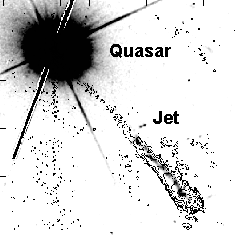Quasars Are Related to Active Galaxies
Quasar Redshifts Imply Enormous Distance and Energy Output
The quasars have very large redshifts, indicating by the Hubble law that they are at great
distances, about 15 billion light years. The fact that they are visible at such
distances implies that they emit enormous
amounts of energy and are certainly not stars.

The Energy Source of Quasars is Extremely Compact
Quasars are extremely luminous at all wavelengths and exhibit variability on timescales as
little as hours, indicating that their enormous energy output originates in a very compact
source.
The timescale for variability of the light from an active galaxy sets an
upper limit on the size of the compact energy source that powers the active galaxy. These
limits are typically the size of the Solar System or smaller.
The present belief is that quasars are actually closely related to nearby active galaxies
(Seyfert Galaxies, Radio Galaxies or BL Lac objects). Quasars have bright nuclei
powered by enormous rotating black holes. However, because the quasars are at such large
distances, it is difficult to see anything other than the bright nucleus of the active galaxy in
their case. As we have noted above, modern observations have begun to detect around
some quasars jets and evidence for the surrounding faint nebulosity of a galaxy-like object
See here.
Abundance of Quasars
in the Early Universe
Looking at large distances in
the Universe is equivalent to
looking back in time because of
the finite speed of light. Thus,
the observation of quasars at
large distances and their
scarcity nearby implies that
they were much more common
in the early Universe than they
are now.
We would expect that generally in the early Universe there
may have been more mass easily accessible to the black hole than later, after much of it had
been consumed. Perhaps later quasars are more dependent on interactions between
galaxies to disturb mass distributions and cause galaxies to begin to feed the hungry black
hole.